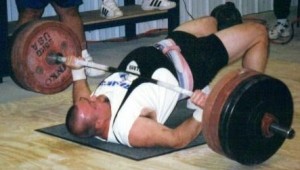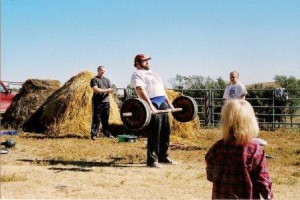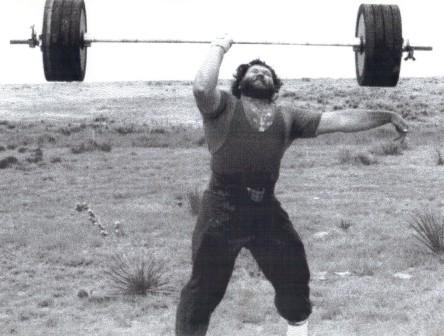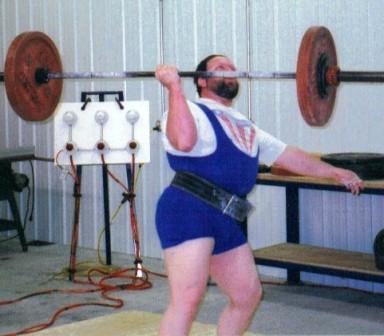The Pullover and Push Part 3 – Technique and my Secret Tips
by Al Myers
Since Part 1 already covered the rules of the Pullover and Push, I am going to assume everyone knows what is expected regarding the rules of this lift. I am going to cover things here that AREN’T in the rules – and hopefully give you suggestions that will help you improve upon this lift. First of all, the Pullover and Push is a violent exercise and not for the “faint of heart”. It is no wonder the modern day Bench Press has replaced it. It is very easy to get hurt doing this exercise, and just being off a little in position and technique can result in injury. I have incurred several injuries myself from this exercise, and I consider myself knowledgeable of the proper technique. At the 2007 Nationals I fractured a carpal bone in my wrist. I have suffered bruised ribs, lacerations to the elbows, bruises to the chest area, wrist injuries, and even a couple of times been knocked unconscious from failing to get my head turned adequately when pulling the bar over my head. Now with THAT being said, if you don’t want to take any of my advice I would completely understand, and maybe THIS LIFT is one you might not want anything to do with! But All-Rounders are a hard-headed group of lifters (myself included), and for some reason like pain and punishment.
A lot of lifters have benched pressed over 500 pounds, with some even doing it without bench shirts and with long pause counts on the chest. But NO ONE has done over 500 pounds in the Pullover and Push! I do think this is possible some day, but it will take a unique lifter who wants to specialize in this lift. One big problem with the Pullover and Push is that it is not a good lift for large lifters. Large lifters with big chests have an obstacle that smaller lifters don’t have – that is first you have to get the bar pulled over your head and chest to even START the push. I have seen many strong bench pressers fail in even getting 200 pounds in position on the chest. It is humbling to be a 400 pound plus bencher and fail with 200 pounds in the Pullover and Push! However, it will take someone with good size to be able to “break” the 500 pound barrier. I think the “ideal body size” for putting up big weight in the Pullover and Push is a lifter around 6 feet tall that weighs between 220 pounds and 240 pounds. The height is needed to enhance an arch (or bridge) and 240 pounds is about the top bodyweight a lifter can weigh before excessive resistance is reached in the Pullover.
I was fortunate to learn many of “my secret techniques” from the best Pullover and Push lifter of All-Time – Bob Burtzloff. Bob has the best lift of All-Time (and the All-Time USAWA Record) at 473 pounds, done in 1987. Bob did over 200 kgs several times in competition. You have to have “NO FEAR” when doing the Pullover and Push. The Pullover and Push has a 1-2 punch, which you must be prepared for and overcome, before you will get to the Push portion of the lift. The first “Punch” is the bar slamming into your chest during the Pullover, and the second “Punch” is the bar impacting your abdomen. You must have your abs “tighten up” when this happens or it will knock the breath out of you. Much like a hard punch to the gut. I like to roll the bar three times on the platform, with the last roll pulling with EVERYTHING I got. I do the first two rolls to get me mentally prepared, much like a basketball player who will bounce the ball a set number of times before a free throw. It is called a Pullover, but THAT is far from how it should be executed, as a pullover implies that you are lifting the bar onto the chest. Instead, the bar should be PROPELLED onto the chest by the momentum of the rolling bar. Some of these tips on the pullover don’t really apply to smaller lifters – as I have seen lightweight lifters literally roll the bar into position onto the chest/abdomen without the plates ever leaving the platform. It is very important to turn your head to the side when the bar is coming over the face as to prevent that knockout blow to the jaw. Once the bar has passed over the face I like to quickly turn my head face up and RAISE my head up as I think it helps drop the chest slightly to help the bar reach its desired location on my upper abdomen. Make sure you wear a shirt that doesn’t have a sticky vinyl logo on the front of it. Do everything you can do to reduce friction on the chest. I like to wear a tight white T-Shirt. Another “trick” is to take a wide grip on the bar (snatch grip). This will shorten the length of “stroke” needed in finishing the push. Even if you are against wrist wraps, this is one lift where you should wear them. The wrists have to “turn over” hard and fast in the transition between the pullover and the push, and lots of stress is placed on them. I also recommend wearing a weight belt. The bridge places lots of pressure on the lower back and a belt helps support the back. I will wear my belt slightly higher on my abdomen than when doing a deadlift, and after I buckle it I leave a loop of belt sticking up. I have on occasion over pulled the bar to the abdomen and if not for this loop of belt “blocking” the bar and causing it to stop, I would have not have been in position to do the push. Two styles of Pushing are used. Smaller lifters tend to pull the bar to the abdomen, let it pause while pulling the feet under, and lift it as high as possible with the bridge before finishing it out with a slight press. Larger lifters (like myself at 6 foot and 250 pounds) like to rebound it quickly from the abdomen to arms’ length. To do this the feet must already be in position by the hips because you will need to bridge quickly. My biggest weights lifted have happened with this technique as I feel I get a “rebound” effect from the abdomen going directly into the bridge. Much like the rebound effect in the Clean and Jerk. However, everything has to be timed perfectly, because if you are slightly out of position you will lose the direct line of push and miss the lift. I find it important to have a mat under my body during the lift. Most lifters do this to cushion the impact of the elbows, but I find I need it to help “stick” myself to the platform. On a slick wood platform during the pullover without a mat, I will pull myself towards the bar and slide on the platform. It is best to use a mat that is thin with a rubber backing. Usually these are not available in competition, so I resort to using a towel which works adequately.
I consider someone who is very proficient in the Pullover and Push to be able to do 150% of bodyweight. A goal everyone should have is to be able to do bodyweight. You are also considered good at the Pullover and Push if you can outlift your best raw Bench Press. You should DEFINITELY be able to do more in the Pullover and Push than the Pullover and Press! I hope I have given a few tips that will help you improve your training in the Pullover and Push.



